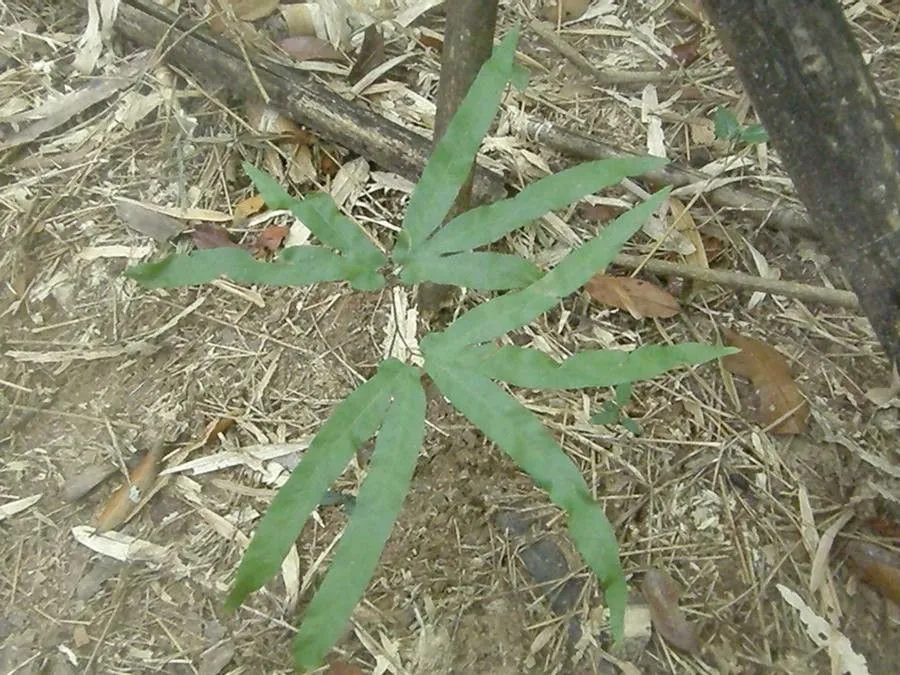
Author: (L.) Sw.
Bibliography: J. Bot. (Schrader) 1800(2): 106 (1801)
Year: 1801
Status: accepted
Rank: species
Genus: Lygodium
Vegetable: False
Observations: Trop. & Subtrop. Asia to N. Australia
The Maidenhair-creeper, known scientifically as Lygodium flexuosum, is a fascinating and unique fern species. This plant is a remarkable member of the Schizaeaceae family and stands out due to its distinct climbing habit, which differentiates it from many other ferns.
The Maidenhair-creeper exhibits twining fronds that can weave their way up through the surrounding vegetation. This makes it an excellent choice for adding vertical interest in garden settings or for natural climbing displays in conservatories. The light green, feathery fronds of this fern mimic the delicate appearance of maidenhair ferns, with finely divided leaflets adding to its ornamental value.
Lygodium flexuosum thrives in tropical and subtropical regions, where it enjoys the warm and humid environments. The plant can be found stretching from tropical and subtropical Asia all the way to Northern Australia. This wide distribution indicates its adaptability to different climatic conditions within these regions.
The species was first described in the early 19th century, with its detailed classification published by Swartz in 1801, featured in the “Journal of Botany” by Schrader. The early documentation of this plant highlights its long-standing recognition and the importance of botanical study in understanding plant diversity around the world.
In the wild, the Maidenhair-creeper often establishes itself in forests, along stream banks, and in other moist habitats where it can receive ample shade and protection from direct sunlight. Gardeners looking to cultivate this fern should try to mimic these natural conditions to ensure the plant’s health and vitality. A consistently moist, well-drained soil, along with dappled light, can recreate an environment similar to its native habitat.
Overall, the Maidenhair-creeper is a graceful and elegant fern that not only adds aesthetic value but also brings a touch of the wild, tropical forest to any garden or indoor space. Its unique climbing ability and delicate fronds make it a plant worthy of appreciation and study, enhancing our understanding of the botanical richness within the Schizaeaceae family.
Eng: maidenhair creeper, maidenhair-creeper
Khm: វល្លិខ្នាញ់
En: Maidenhair-creeper, Maidenhair creeper
Km: វល្លិខ្នាញ់
Taken Feb 6, 2009 by Marcel B. (cc-by-sa)
Taken Oct 3, 2021 by sama ape (cc-by-sa)
Taken Jul 4, 2021 by straynger (cc-by-sa)
© copyright of the Board of Trustees of the Royal Botanic Gardens, Kew.
© copyright of the Board of Trustees of the Royal Botanic Gardens, Kew.
© copyright of the Board of Trustees of the Royal Botanic Gardens, Kew.
Growth habit>: Vine
Family: Myrtaceae Author: (F.Muell.) K.D.Hill & L.A.S.Johnson Bibliography: Telopea 6: 402 (1995) Year: 1995 Status:…
Family: Rubiaceae Author: Pierre ex A.Froehner Bibliography: Notizbl. Bot. Gart. Berlin-Dahlem 1: 237 (1897) Year:…
Family: Sapindaceae Author: Koidz. Bibliography: J. Coll. Sci. Imp. Univ. Tokyo 32(1): 38 (1911) Year:…
Family: Asteraceae Author: A.Gray Bibliography: Pacif. Railr. Rep.: 107 (1857) Year: 1857 Status: accepted Rank:…
Family: Fabaceae Author: Medik. Bibliography: Vorles. Churpfälz. Phys.-Ökon. Ges. 2: 398 (1787) Year: 1787 Status:…
Family: Aspleniaceae Author: (Cav.) Alston Bibliography: Bull. Misc. Inform. Kew 1932: 309 (1932) Year: 1932…